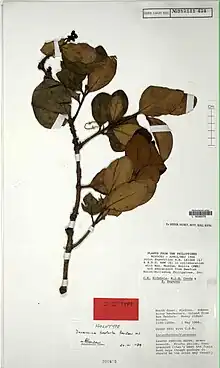Cyne (plant)
Cyne is a genus of flowering plants belonging to the family Loranthaceae.[1]
| Cyne | |
|---|---|
 | |
| Cyne baetorta holotype herbarium specimen | |
| Scientific classification | |
| Kingdom: | Plantae |
| Clade: | Tracheophytes |
| Clade: | Angiosperms |
| Clade: | Eudicots |
| Order: | Santalales |
| Family: | Loranthaceae |
| Genus: | Cyne Danser |
| Synonyms | |
|
Tetradyas Danser | |
It is native to the Philippines,[2] the Maluku Islands and New Guinea.[1][3][4] They are found at elevations ranging from sea level to subalpine.[5]
Description
They are parasitic plants with epicortical roots (on top of the bark) and secondary haustoria (a structure developed for penetrating the host plant's tissues). The leaves are decussate (opposite with successive pairs borne at right angles to the last) and the venation is pinnate. It has flowers which are a much contracted raceme of 1 or more decussate pairs of triads (groups of three). They are rarely dyads (groups of 2), developing below and breaking through a shell of cork, raising a rupturing blister or calyptra as the flowers expand.[4] The triads and flowers have minute peduncles (flower stalks) and pedicels, each flower has a bract (modified leaf), those of each triad forming an involucre (flower and leaf structure). It has 6 or more petals,[4] which are more or less choripetalous (having separate petals). The anthers are basifixed,[4] and sessile (attached without a stalk). The style is often basally articulate and the stigma is usually capitate (looking like the head of a pin). The fruit (or seed capsule) is ellipsoid (in shape), with a persistent stylar base.[3]
Known species
- Cyne baetorta Barlow
- Cyne banahaensis (Elmer) Danser
- Cyne monotrias Barlow
- Cyne papuana (Danser) Barlow
- Cyne perfoliata (Danser) Barlow
- Cyne quadriangula Danser
The type species is Cyne banahaensis.[5]
Taxonomy
The genus name of Cyne is presumed to be of French origin and means "Moon". It also could refer to the Old English word cyne meaning royal.[6] It was first described and published in Bull. Jard. Bot. Buitenzorg, séries 3, Vol.10 on page 306 in 1929.[1]
The genus is recognized by the United States Department of Agriculture and the Agricultural Research Service, but they do not list any known species.[7]
References
- "Cyne Danser | Plants of the World Online | Kew Science". Plants of the World Online. Retrieved 4 January 2022.
- P. Baas, K. Kalkman R. Geesink (Editors) The Plant Diversity of Malesia: Proceedings of the Flora Malesiana Symposium ... (2012) , p. 286, at Google Books
- Job Kuijt and Bertel Hansen (Klaus Kubitzki) The Families and Genera of Vascular Plants: Flowering Plants. Eudicots: Santalales, Balanophorales (2015), p. 111, at Google Books
- James W. Byng The Flowering Plants Handbook: A practical guide to families and genera of ... (2014), p. 333, at Google Books
- "Cyne Genus Page". parasiticplants.siu.edu. Retrieved 4 January 2022.
- Robert Hunter The Encyclopaedic Dictionary: A New & Original Work of ..., Volume 4, Part 2 (1885), p. 482, at Google Books
- "Genus Cyne Danser". npgsweb.ars-grin.gov. Retrieved 4 January 2022.
Other sources
- Barlow, B.A. (1993) Conspectus of the Genera Amylotheca, Cyne, Decaisnina, Lampas, Lepeostegeres, and Loxanthera (Loranthaceae). Blumea 38: 65–126.